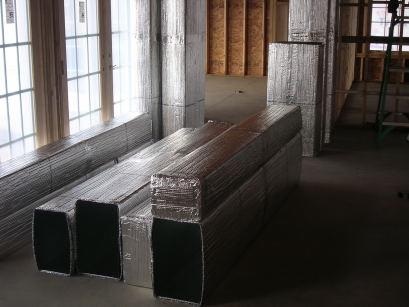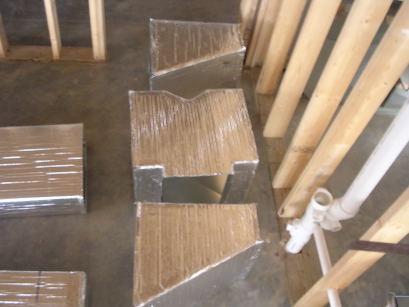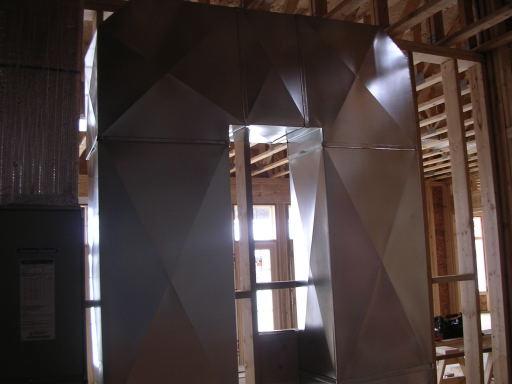Contact us at (540) 483-0725

Ducting for ventilation comes in many forms. Sheet metal duct is the most common of all ducting although there is another form known as duct board.
Sheet Metal
Sheet metal duct is made from galvanized steel. It has many advantages. It is a good corrosion resistant product, available in different gauges for strength against abuse, can be produced in many shapes and/or sizes to fit unusual locations, excellent air flow properties and resist damage from water unlike most other products.
Sheet metal can be insulated in different ways. Insulation can be wrapped on the outside of the duct for insulation properties while reducing restrictions on the inside of the duct and reducing places for dust and particles to be trapped. Sheet metal ducting that is lined on the inside for insulation value allows for dust and particles to be trapped in the exposed part of the insulation, restricted air flow and increases the chances of mold or mildew.
Duct Board
Duct board is a less expense way to create ducting. It consists of compressed fiberglass with a reflective paper bonded to the outside to different thickness levels of insulation. This type of duct has similar issues as lined sheet metal ducting. It is more restrictive to air flow, allows dust and particles to be trapped in the exposed part of the insulation, fragile and hold moisture, increasing the chance of mold or mildew. It is chemically treated to aid with the reduction of mold/mildew. Duct board is vulnerable to small critters that can very easily chewing their way into your duct system or home.
In summary, our company feels that duct board has the most disadvantages over all the ducting products. Due to its vulnerability to critters chewing into the ducting, the structure of the duct board being weak and only held together with staples and duct tape, restrictions and places for dust and particles to be trapped in the exposed parts of the insulation thus making a very cheap duct system. Sheet metal ducting lined on the inside is durable but has the issues with exposed insulation capturing dust and particles and allowing possible changes of mold and mildew to occur. Sheet metal ducting insulated on the outside is a better choice of ventilation because it is less restrictive due to the smooth surface of the sheet metal, not allowing places for dust and particles to be trapped thus decreasing the chances of mold and mildew. This type of ducting also allows duct cleaning services to better clean your duct system.
Flexible Ducting
Flexible ducts, known as flex, are typically flexible plastic over a metal wire coil to make round, flexible duct. The next layer is a layer of fiberglass insulation that covers the duct, and then an out side jacket of vinyl or foil layer protects the insulation. Flexible duct is excellent for reducing noise from equipment, faster installation time, can be installed in all environments except outdoors, outside jackets are solid giving the duct a good vapor barrier, it can be easily replaced and/or repaired and comes made in 25 foot lengths so it reduces the number of connections. One thing to note about flexible ducting, it does make installation easier and reduces noise from equipment , but still needs to be installed correctly. The flex runs need to remain as short as possible with the least turns possible due to restriction in air flow to prevent losing efficiency in your system.
Remember the heating and cooling system in your home recirculates the air you breathe and the quality of the air can affect you. Poor duct connections in crawl spaces and attics allow unwanted air to be brought into your home resulting in possible poor air quality due to molds and mildew in crawl space and well as dust and debris. Having a quality duct system with metal supply ducting with the least amount of flexible ducting can increase the efficiency of your system and help lower operating costs. Below I have included several pictures to help show the difference between the types of duct systems discussed above.
 |
 |
 |
 |
 |
Sheet Metal Ducting and Fittings insulated on outside
 |
 |
 |
 |
|---|---|---|---|
 |
 |
||
 |
|||
Franklin Heating and Air Conditioning
Telephone (540) 483-0725
Email: comfortzone@franklinheatandair.com